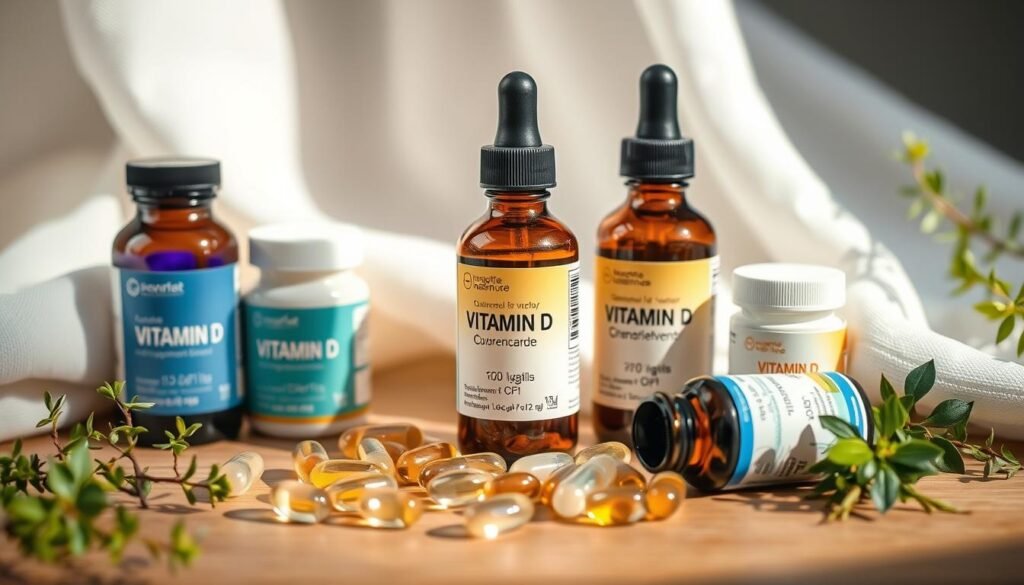Nearly one in four people in the U.S. have too low vitamin D levels. This impacts their bones and overall health badly. Vitamin D is key for healthy bones because it helps in absorbing calcium. This article will teach you how much vitamin D you need for strong bones. It will cover vitamin D needs for different ages and the daily amount you should get. By the end, you’ll know how to avoid vitamin D deficiency with food and supplements.
Key Takeaways
- The recommended daily intake of vitamin D changes with age. Kids need 400 IU and adults up to 70 years need 600 IU.
- People over 70 should get 800 IU of vitamin D each day.
- Not having enough vitamin D can cause big problems for bone health, like osteoporosis.
- You can get vitamin D from some foods and the sun.
- Breastfed babies need a supplement of 400 IU of vitamin D daily.
- Knowing your vitamin D level is key to keeping bones healthy.
Introduction to Vitamin D and Bone Health
Vitamin D is key for strong bones. It helps the body take in calcium from foods, keeping bones solid and healthy. Without enough vitamin D, our bodies cannot absorb calcium well. This makes it hard for bones to stay strong.
Many people, especially in places with less sun, don’t get enough vitamin D. This makes bones weak and more likely to break. Children can get rickets, a disease that causes bone problems. Everyone, from kids to older adults, needs good levels of vitamin D.
Knowing how vitamin D works with calcium is important for bone health. Research shows that calcium and vitamin D together make bones stronger. This is especially true for older women. Eating right and getting enough vitamin D helps keep bones healthy and strong.
| Age Group | Recommended Daily Intake of Vitamin D (IU) | Maximum Safe Limit (IU) |
|---|---|---|
| 0 to 12 months | 400 | Not established |
| 1 to 18 years | 600 | 2,500-3,000 |
| 1 to 70 years | 600 | 4,000 |
| Over 70 years | 800 | 4,000 |
Eating foods rich in vitamin D is a great way to get enough of it. Foods like fatty fish and fortified products are good choices. The right balance of vitamin D and calcium is crucial for keeping bones healthy for life.
What Is Vitamin D and Its Role?
Vitamin D is a key nutrient that our bodies need, especially for bone health. It helps bones absorb calcium, which keeps them strong. There are two types of vitamin D: D2 and D3. D3 is especially good at boosting vitamin D levels in our blood.
The importance of vitamin D goes beyond just bones. It’s crucial for our cells, immune system, and muscles. Having enough vitamin D can help us stay active and prevent falls, especially as we get older.
Lacking vitamin D can lead to health issues. Kids might get rickets, which makes their bones soft and bendy. Adults could face osteoporosis, where bones get weak and break easily. Doctors check vitamin D levels with a special blood test called 25(OH)D.
| Vitamin D Status | Serum Level (nmol/L) |
|---|---|
| Insufficient | Less than 50 |
| Optimal | 50-100 |
| Toxic Levels | Above 250 |
Knowing about vitamin D benefits helps us choose better foods and lifestyle habits. This can lead to stronger bones and a healthier life.
How Much Vitamin D Do We Need?
It’s very important to know how much vitamin D we need for our bones to be strong. Every age group has different needs for vitamin D. By knowing the age-specific requirements, we can avoid deficits. This keeps us healthy.
Age-Specific Requirements for Vitamin D
The amount of vitamin D needed changes with age. Here is a quick guide:
| Age Group | Daily Requirement (mcg) | Daily Requirement (IU) |
|---|---|---|
| 0–12 months | 10 mcg | 400 IU |
| 1–18 years | 15 mcg | 600 IU |
| 19–70 years | 15 mcg | 600 IU |
| 71 years and older | 20 mcg | 800 IU |
Meeting these age-specific requirements ensures we get enough vitamin D. This lowers the chance of bone problems.
Understanding IU and mcg Measurements
Vitamin D can be measured in International Units (IU) or micrograms (mcg). One microgram equals 40 IU. Vitamin D measurements knowledge is key for using supplements correctly. For babies under one year, 10 mcg or 400 IU is necessary. It’s crucial to get enough vitamin D from food, supplements, or the sun.
Health Benefits of Vitamin D for Bones
Vitamin D is key for bone health, as it helps the body absorb calcium. This nutrient makes sure calcium is used right, keeping bones strong. People who get enough vitamin D have better bone density and health.
Calcium Absorption and Bone Strength
For our bodies to absorb calcium well, we need enough vitamin D. With enough of this vitamin, our bodies can use calcium from food and supplements better. Proper calcium intake is crucial for strong bones Without it, bones might get weak and break more easily.
Preventing Osteoporosis and Osteomalacia
The benefits of vitamin D include fighting against osteoporosis and osteomalacia, which make bones brittle and soft. Keeping vitamin D levels up can lower older adults’ osteoporosis risk. Not having enough can make osteomalacia worse, where bones soften. Staying on top of your vitamin D intake helps keep bones healthy for life.
Consequences of Vitamin D Deficiency
Knowing the consequences of not having enough vitamin D is key for good health. Not having enough can lead to different health problems. People with low levels of vitamin D can face many issues every day.
Common Symptoms of Deficiency
Vitamin D deficiency can show in many ways, like:
- Muscle weakness
- Fatigue
- Bone pain
- Increased susceptibility to fractures
Spotting these signs early can help stop worse problems. This makes it urgent for people to get tested and treated right away.
Long-term Health Implications
The impact of ignoring low vitamin D can be very serious. If it goes on for too long, it may cause:
- Osteoporosis: This means bones get weak and break easily.
- Cardiovascular diseases: There’s a higher chance of heart problems with low vitamin D.
- Cognitive decline: Research shows not enough vitamin D can lead to worse memory or thinking skills over time.
These serious risks show why it’s crucial to keep vitamin D levels up. This can be done through food, pills, or getting some sun.
Natural Sources of Vitamin D
It’s crucial to get enough vitamin D for healthy bones. While sunlight is a well-known source, various vitamin D-rich foods are also important. By combining these sources, you can achieve your daily needs.
Foods Rich in Vitamin D
For proper vitamin D levels, it’s wise to eat different foods with vitamin D. Some great options include:
- Fatty fish: Fish like salmon, mackerel, and tuna are top choices, with a single piece of swordfish providing up to 706 IU.
- Fortified dairy products: A cup of whole milk has about 124 IU, aiding significantly in meeting daily goals.
- Fortified cereals: Cereals such as Cheerios offer around 5% of the daily value per serving.
- Mushrooms: Some mushrooms, especially those UV-exposed, offer nearly 100% of the daily value in one serving.
- Cod liver oil: With 1,360 IU per tablespoon, this oil is a highly effective source.
Adding these foods to your diet can address low vitamin D levels, especially with little sun exposure. For more on vitamin D sources, see this link.
Importance of Sun Exposure
Being in the sun helps your body make vitamin D. About 10 to 15 minutes outside several times a week is enough for most people. This depends on your skin type, where you live, and the time of year. However, some people find it hard to get enough sun because:
- They live in places with little sunlight, especially in winter.
- They use sunscreen, which lowers vitamin D production in the skin.
- They have darker skin, needing more sun to produce the same vitamin D amount as those with lighter skin.
Keeping a balance between your diet and sun exposure is key to avoiding vitamin D shortages. This supports your bone health.

Recommended Daily Intake of Vitamin D
Understanding the recommended daily intake vitamin D is key for good health and strong bones. Health groups have set guidelines by age to help everyone get the right amount. This helps people maintain their bone health effectively.
General Guidelines for Different Age Groups
The recommended daily intake varies for different ages:
| Age Group | Recommended Daily Intake (IU) |
|---|---|
| Infants (0-12 months) | 400 IU |
| Children and Adults (1-70 years) | 600 IU |
| Seniors (71 years and older) | 800 IU |
These vitamin D guidelines make sure most people get enough for their health. It’s vital to know that those in areas with little sun might need more. They should adjust their intake accordingly.
Discussion on Safe Upper Limits
It’s not only about getting enough vitamin D but also avoiding too much. Adults should stick to less than 4,000 IU daily to prevent toxicity. Taking too much can cause nausea, weakness, and high blood calcium.
With the growing interest in vitamin D’s health benefits, it’s wise to talk to a doctor. They can help adjust your vitamin D based on your health needs. This ensures you stay healthy.
Vitamin D Supplements: When and How to Take Them
Vitamin D supplements are key for people who can’t get enough from food and sun. Nearly 29% of adults in the U.S. are not getting enough, making it crucial to know about the supplements and how to use them properly.
Types of Vitamin D Supplements
The two primary types of vitamin D supplements are:
- Vitamin D2 (ergocalciferol) – Typically derived from yeast and fungi.
- Vitamin D3 (cholecalciferol) – Often sourced from fish liver oil or made through lanolin, and it’s better at increasing vitamin D levels in the blood.
Picking the right vitamin D supplement is very important for its success.
Best Practices for Supplementation
When adding vitamin D to your daily life, follow these tips:
- Taking vitamin D with your biggest meal can help your body absorb it better. This can raise your blood levels by about 50% in 2–3 months.
- If you take the supplement with a meal that has a lot of fat, you could see a 32% increase in blood levels in just 12 hours. This doesn’t happen with fat-free meals.
- It’s a good idea to talk to a doctor before starting, especially if you already have health issues or take other meds.
- You might need to think about the best time to take it. Some people say taking it at night can mess with sleep, but there’s not a lot of science to back that up yet.
Find a daily routine that fits your life and take the right amount for your age and health needs.

| Age Group | Recommended Daily Intake (IU) |
|---|---|
| Birth to 12 months | 400 |
| Children aged 1 to 13 years | 600 |
| Teens aged 14 to 18 years | 600 |
| Adults aged 19-70 years | 600 |
| Adults aged 71 years and older | 800 |
| Pregnant or breastfeeding individuals | 600 |
Understanding Vitamin D Blood Levels
Checking vitamin D in your blood is key for good health. It helps decide the right diet steps. Doctors usually look at the 25-hydroxyvitamin D type. This is done in ng/mL or nmol/L units. Knowing these numbers helps choose how much vitamin D you need.
How Vitamin D Levels Are Measured
The best way to measure vitamin D is with the 25-hydroxy vitamin D test. It tells us how much vitamin D is in the blood. A normal level is seen as 20-40 ng/mL. But, some say 30-50 ng/mL is best for health. If it goes below 20 ng/mL, that’s not enough vitamin D.
Not having enough can lead to higher parathyroid hormone levels. This could cause health problems.
What Do the Numbers Mean?
Understanding your vitamin D test numbers is crucial. Here’s a brief look at what they show:
| Vitamin D Level (ng/mL) | Status | Implications |
|---|---|---|
| Below 20 | Deficient | Increased risk of bone issues, might need more vitamin D. |
| 20 – 29 | Suboptimal | May lead to high parathyroid hormone; changes needed. |
| 30 – 100 | Optimal | Good for bones and overall health. |
Testing often is key, especially if you’re at high risk for low levels. Getting the right amount from foods or pills helps keep bones strong. For more details, see this resource on vitamin D health.
At-Risk Groups for Vitamin D Deficiency
Vitamin D deficiency is a big health risk for some people. Knowing who is at risk is key for prevention and treatment. It’s important to check regularly for vitamin D deficiency.
Identifying Individuals at Higher Risk
Some groups are more likely to lack vitamin D. They include:
- Older adults, as age affects the skin’s ability to synthesize vitamin D.
- Individuals with darker skin, who produce less vitamin D due to higher melanin content.
- Nursing home residents and hospitalized patients, with deficiency rates ranging from 50% to 60%.
- Obese individuals, as body fat can sequester vitamin D, rendering it less available for use.
- Infants who are exclusively breastfed and do not receive vitamin D supplementation, with significant deficiency rates in various regions.
In the United States, 61% of elderly people have low vitamin D. In Turkey and India, over 90% of babies have this issue.
Importance of Regular Testing
Testing for vitamin D deficiency is crucial for at-risk groups. Regular checks via serum 25-hydroxyvitamin D tests help catch it early. This can prevent issues like fractures and bone problems.

Conclusion
Vitamin D is key for strong bones and good health. Knowing how much you need each day is crucial. This can help reduce the risk of bone loss and muscle issues. People should get vitamin D from the sun and foods like oily fish and liver.
Many might not get enough vitamin D from food alone. Taking extra vitamin D can be a good idea. Up to 4,000 IU a day is safe for most, but often less is enough. If you don’t get much sun or have dark skin, you might need supplements regularly. It’s smart to check your vitamin D levels with a doctor to stay healthy.
If you want to know more about vitamin D and health, there’s lots of research out there. Optimal vitamin D levels support your health and activity. To learn more, check out the latest studies and health tips about vitamin D benefits here.